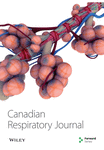Inhaled Corticosteroids in COPD: Determinants of Use and Trends in Patient Persistance with Treatment
Abstract
METHODS: The determinants of a new treatment with inhaled corticosteroids and secular trends in patient persistence with treatment among chronic obstructive pulmonary disease (COPD) patients were investigated. A cohort of 3768 physician-diagnosed, elderly COPD patients was selected between 1990 and 1996 from the health care administrative database of the Régie de l′assurance maladie du Québec. A nested case-control design was used to identify patient and physician characteristics that were associated with a new treatment with inhaled corticosteroids. Treatment persistence with inhaled corticosteroids was also estimated using Kaplan-Meier analysis. In addition to that, changes in treatment persistence over time, from 1990 to 1995, were investigated by estimating the yearly proportion of patients persisting for less than one year.
RESULTS: Within the cohort, the yearly percentage of patients filling at least one prescription for inhaled corticosteroids was 42.2% in 1990 and increased to 53.1% in 1995 (P=0.001). Using a conditional logistic regression model, it was found that the patients most likely to initiate a treatment with inhaled corticosteroids were those who had severe COPD (rate ratio [RR] 1.7; 95% CI 1.4 to 2.0), those who were hospitalized for COPD (RR 10.0; 95% CI 5.6 to 17.9), those who consulted a respirologist in the previous month (RR 2.3; 95% CI 1.6 to 3.3) or those who visited more than three different physicians in the previous three months (RR 1.6; 95% Cl 1.3 to 1.9). The proportion of patients persisting with inhaled corticosteroids for less than one year rose by 19.4%, from 47.6% in 1990 to 67.0% in 1995 (P=0.011; test for trend).
CONCLUSIONS: The use of inhaled corticosteroids increased while patient persistence decreased between 1990 and 1995. Disease severity, as well as recent consultation to a respirologist and multiple visits to a physician, were associated with a strong likelihood of being prescribed inhaled corticosteroids. The cost of this practice is far from negligible, while their clinical impact is still uncertain.




